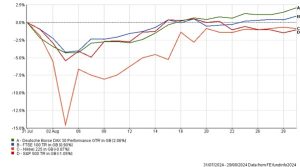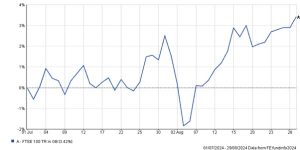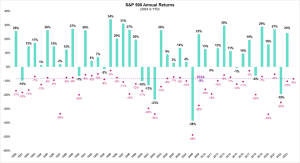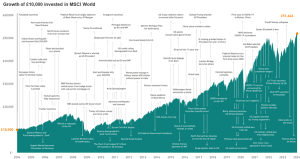With investing, time is your friend
2nd September 2024
-
Gavin Jones See profile
One of the great challenges that all investors face is that there is no easy or quick way to investment success. Aesop’s fable of the tortoise and the hare is a useful metaphor. You have to use the time on your side – which could be over multiple decades – to capture the returns of the markets effectively, but often slowly. In the short term, market returns can be disappointing. The longer you can hold for, the more likely the returns you receive will be at worst survivable, and hopefully far more palatable. It is time that allows small returns to compound into large differences in outcome for the patient investor. The reality is that markets go up and down with regular monotony.
‘The stock market is a device for transferring money from the impatient to the patient’.
Warren Buffett
The latest evidence of this happened at the beginning of August when we saw sharp short term falls in global stock markets. Media headlines reported that the main Japanese stock market, the Nikkei 225 fell by over 12%, early morning on 5 August, its biggest fall since 1987. Alongside that, there was a wider global sell off after data from the US which has shown economic weakness.
A kneejerk reaction to this, if anyone was tempted to sell, would have meant missing out on the Nikkei bouncing back by a record jump of 10% the next day. The graph below shows the market movements of several of the world’s main stock markets with the fall and subsequent recovery to the 29 August.

If you want to be a successful investor, you have to be patient. On your investing journey, you will spend a lot of time going backwards, recovering from the setback and then surging forward again, often in short, sharp bursts of upward market movement. You just have to stick with it. Remember that you have to be in the markets to capture their returns. Impatient investors tend to lose faith in their investments too quickly, often with painful consequences.
Before the UK General Election, we cautioned on the dangers of trying to predict the outcome of elections and that markets will have priced in the probability of a Labour government and what it thinks about its policies, as far as they are known. That is what markets do. They incorporate all public information into prices quickly and efficiently, meaning that prices only move on the release of new information, which is random. The stock market tends to be resilient for those with the patience to sit out any passing market storms.
Looking at the movement of the main UK stock market – the FTSE100 shows very little movement before and after the Election results on 6 July.

It really is pointless to try to predict an outcome any different to that already reflected in today’s market prices. There are no certainties in investing, but investors can give themselves the best chance of achieving their expectations by allowing the passage of time to let short term uncertainty be overwhelmed by long term expected outcomes.
‘In the short run, the market is a voting machine but in the long run, it is a weighing machine.’
Benjamin Graham
The chart below was published at the beginning of August as we were seeing stock market falls. The pink dots on the chart show the peak to trough falls in the main US stock market – the S&P 500 each year. The pain you will have lived through, watching the market fall from the high. The blue bars show the return over that year. The money you would have made from staying invested, start to finish.

Source: Factset, Past performance is not a guide to future returns, chart(s)/data for illustration purposes only.
At the time the chart was produced, the S&P 500 was down 9%. Most years see falls of more than that.
There will be some years where the overall return is negative, although you can see the annual return is never usually as bad as the greatest fall in any year. These periods are the risks that equity investors have to bear to get rewarded by above inflation returns over the longer term.
The thing with market selloffs is that there’s always a different event to last time, and it’s usually something that you hadn’t even heard of a few months before.
Trading the headlines isn’t a sensible way to live your life – high stress, for very little reward. The chart below shows significant events over the growth of the MSCI World index – illustrating the growth of developed markets.

Source: Factset, Past performance is not a guide to future returns, chart(s)/data for illustration purposes only.
Of course, your portfolios don’t just incorporate the MSCI World or the S&P500. Reflecting the risk you want or need to take, you have a sensibly diversified portfolio containing sufficient higher-quality, shorter-dated bonds to provide protection from portfolio falls, allowing you to stay invested throughout these inevitable episodes of market turmoil that arise from time to time.
That’s what proper diversification delivers. The ability to perform without having to ‘time’ markets based on headlines.

